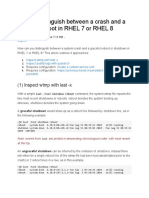0 ratings0% found this document useful (0 votes)
92 viewsSystemd Cheatsheet
This document provides a cheatsheet comparing commands for managing services and system states between SysV init and systemd. It lists the equivalent commands for starting, stopping, restarting, checking status of services, enabling or disabling services at boot, and checking and changing the system runlevel or target unit. Additional systemd-specific commands are also included for managing logs, checking for failed units, listing targets and jobs, and changing power states.
Uploaded by
Susant SahaniCopyright
© © All Rights Reserved
Available Formats
Download as PDF, TXT or read online on Scribd
0 ratings0% found this document useful (0 votes)
92 viewsSystemd Cheatsheet
This document provides a cheatsheet comparing commands for managing services and system states between SysV init and systemd. It lists the equivalent commands for starting, stopping, restarting, checking status of services, enabling or disabling services at boot, and checking and changing the system runlevel or target unit. Additional systemd-specific commands are also included for managing logs, checking for failed units, listing targets and jobs, and changing power states.
Uploaded by
Susant SahaniCopyright
© © All Rights Reserved
Available Formats
Download as PDF, TXT or read online on Scribd
You are on page 1/ 1
Systemd Cheatsheet
Sysvinit Command Systemd Command Notes
service httpd start systemctl start httpd.service Used to start a service (not reboot persistent).
service httpd stop systemctl stop httpd.service Used to stop a service (not reboot persistent).
service httpd restart systemctl restart httpd.service Used to stop and then start a service.
service httpd reload systemctl reload httpd.service When supported, reloads the cong le without
interrupting pending operations.
service httpd condrestart systemctl condrestart httpd.service Restarts if the service is already running.
service httpd status systemctl status httpd.service Tells whether a service is currently running.
service --status-all systemctl list-units --type service Displays the status of all services.
ls /etc/rc.d/init.d/ systemctl list-unit-files --type=service Used to list the services that can be started or
stopped. Used to list all the services and other
units.
chkconfig httpd on systemctl enable httpd.service Turn the service on, for start at next boot, or other
trigger.
chkconfig httpd off systemctl disable httpd.service Turn the service o for the next reboot, or any
other trigger.
chkconfig httpd systemctl is-enabled httpd.service Used to check whether a service is congured to
start or not in the current environment.
chkconfig --list systemctl list-unit-files --type=service
ls /etc/systemd/system/*.wants/
Print a table of services that lists which runlevels
each is congured on or o.
chkconfig httpd --list ls /etc/systemd/system/*.wants/httpd.service Used to list what levels this service is congured
on or o.
chkconfig httpd --add systemctl daemon-reload Used when you create a new service le or modify
any conguration.
Sysvinit Runlevel Systemd Target Notes
0 runlevel0.target, powero.target Halt the system.
1, s, single runlevel1.target, rescue.target Single user mode.
2, 4 runlevel2.target, runlevel4.target, multi-user.target User-dened/Site-specic runlevels - identical to 3.
3 runlevel3.target, multi-user.target Multi-user, non-graphical. Users can usually login via
multiple consoles or via the network.
5 runlevel5.target, graphical.target Multi-user, graphical. Usually has all the services of run-
level 3 plus a graphical login.
6 runlevel6.target, reboot.target Reboot
emergency emergency.target Emergency shell
Command Notes
systemctl get-default Determine which target unit is used by default.
systemctl set-default multi-user.target Change default boot target to multi-user.target.
journalctl -b Show all messages from this boot.
journalctl -b -p err Show all messages of priority levels ERROR (4) and worse, from the
current boot.
journalctl -p warning --since="2014-06-14 23:59:59" View the warning or higher priority messages from certain point in time.
journalctl -f Follow new messages.
journalctl /usr/sbin/httpd Show all messages by a specic executable.
journalctl --full Display full (= not truncated) messages.
systemctl --state=failed Lets nd the systemd services which fail to start.
systemctl list-units --type=target Show current runlevel.
systemctl isolate graphical.target Changes the current target (runlevel).
systemctl rescue/emergency Changing to Rescue(single user mode)/Emergency Mode.
systemd-cgls cgroup tree
systemctl show -p "Wants" multi-user.target What other units does a unit depend on?
systemctl list-jobs Check for possibly stuck jobs use.
Old Command Systemd Command Description
halt systemctl halt Halts the system.
poweroff systemctl poweroff Powers o the system.
reboot systemctl reboot Restarts the system.
pm-suspend systemctl suspend Suspends the system.
pm-hibernate systemctl hibernate Hibernates the system.
pm-suspend-hybrid systemctl hybrid-sleep Hibernates and suspends the system.
This card may be freely distributed under the terms of the GNU general public licence
You might also like
- Back Testing With 99 Percent Modelling V1No ratings yetBack Testing With 99 Percent Modelling V14 pages
- Active Directory Users and Computers - II Additional Domain ControllerNo ratings yetActive Directory Users and Computers - II Additional Domain Controller4 pages
- Systemd On Linux - Manage Services, Run Levels and Logs100% (1)Systemd On Linux - Manage Services, Run Levels and Logs8 pages
- Step by Step Linux Boot Process (Centos/Rhel 8)100% (1)Step by Step Linux Boot Process (Centos/Rhel 8)6 pages
- Linux - CentOS System Administrator PrepNo ratings yetLinux - CentOS System Administrator Prep4 pages
- Start, Stop and Restart Services in Linux Using Systemctl CommandNo ratings yetStart, Stop and Restart Services in Linux Using Systemctl Command6 pages
- Systemd Commands Cheat Sheet: Application Management Using Systemctl CommandsNo ratings yetSystemd Commands Cheat Sheet: Application Management Using Systemctl Commands5 pages
- Controlling The Boot Process: Selecting A Systemd TargetNo ratings yetControlling The Boot Process: Selecting A Systemd Target10 pages
- Understanding Systemd: Boston Linux UNIX March 2016100% (1)Understanding Systemd: Boston Linux UNIX March 201660 pages
- Chapter 6. Controlling Access To Services: Section 6.4, "Additional Resources"No ratings yetChapter 6. Controlling Access To Services: Section 6.4, "Additional Resources"6 pages
- Controlling Services and Daemons: Active - All - State Load Active SUBNo ratings yetControlling Services and Daemons: Active - All - State Load Active SUB4 pages
- Lesson 6 - Booting, Initializing, and Virtualizing Linux - Part 2No ratings yetLesson 6 - Booting, Initializing, and Virtualizing Linux - Part 227 pages
- Systemd Cheat Sheet: List All Available ServicesNo ratings yetSystemd Cheat Sheet: List All Available Services2 pages
- Cheatsheet: Apache Server (HTTPD) Monitoring: More InfoNo ratings yetCheatsheet: Apache Server (HTTPD) Monitoring: More Info2 pages
- How To Distinguish Between A Crash and A Graceful Reboot in RHEL 7 or RHEL 8No ratings yetHow To Distinguish Between A Crash and A Graceful Reboot in RHEL 7 or RHEL 86 pages
- Quick Reference Administering AIX V5.2 Version 1.0: DisclaimerNo ratings yetQuick Reference Administering AIX V5.2 Version 1.0: Disclaimer25 pages
- The Linux Boot Sequence: Administrator's Guide and From Chap. 6 of Linux UnleashedNo ratings yetThe Linux Boot Sequence: Administrator's Guide and From Chap. 6 of Linux Unleashed7 pages
- Chapter 12. Controlling Access To Services: Prev NextNo ratings yetChapter 12. Controlling Access To Services: Prev Next11 pages
- Operating Systems: Assignment 1: System Calls and SchedulingNo ratings yetOperating Systems: Assignment 1: System Calls and Scheduling6 pages
- Systemd Evolution Revolution RegressionNo ratings yetSystemd Evolution Revolution Regression18 pages
- Beyond Init: Systemd: Linuxkongress 2010No ratings yetBeyond Init: Systemd: Linuxkongress 201046 pages
- PM0085-B Brochure, OPTI CCA-TS2, English (Web)No ratings yetPM0085-B Brochure, OPTI CCA-TS2, English (Web)4 pages
- Career Objective: Chiranjeevi Oracle Apps Technical Cell: +91-8801136343No ratings yetCareer Objective: Chiranjeevi Oracle Apps Technical Cell: +91-88011363432 pages
- PAC Productivity Suite: Integrated PLC and SCADA SolutionNo ratings yetPAC Productivity Suite: Integrated PLC and SCADA Solution6 pages
- Full download An Introduction to Parallel Programming Pacheco Peter S Malensek Matthew pdf docx100% (1)Full download An Introduction to Parallel Programming Pacheco Peter S Malensek Matthew pdf docx54 pages
- Best of Both Worlds - Combine KG and Vector Search For Enhanced RAG - Neo4jNo ratings yetBest of Both Worlds - Combine KG and Vector Search For Enhanced RAG - Neo4j40 pages
- Videoedge 2U Network Video Recorder: Data SheetNo ratings yetVideoedge 2U Network Video Recorder: Data Sheet3 pages
- Purchase Order: Contract Creation: Step 1: Go To Transaction CodeNo ratings yetPurchase Order: Contract Creation: Step 1: Go To Transaction Code18 pages
- (If RND 602U 1063) Xelis Dental 1.0.6.3 User Guide - EngNo ratings yet(If RND 602U 1063) Xelis Dental 1.0.6.3 User Guide - Eng280 pages
- PDF Transformer, BERT, and GPT: Including ChatGPT and Prompt Engineering (MLI Generative AI Series) 1st Edition Campesato download100% (5)PDF Transformer, BERT, and GPT: Including ChatGPT and Prompt Engineering (MLI Generative AI Series) 1st Edition Campesato download40 pages
- Lecture 3 Software ReEngineering 10102022 104311amNo ratings yetLecture 3 Software ReEngineering 10102022 104311am37 pages































































































